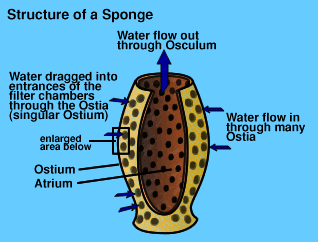
They rely on keeping up a constant water flow through their bodies to obtain food and oxygen and to remove wastes. Sponges do not have a nervous, digestive or circulatory system. Spongia officinalis, the bath sponge, have no spicules at all. Some sponges also secrete exoskeletons that lie completely outside their organic components whilst others, e.g. Spicules vary in shape from simple rods to three-dimensional "stars" with up to six rays. Many also have a skeleton made up of spicules of calcium carbonate or silica. The animals eventually grow too large to escape the sponge, so they are forced to "stay put" for the rest of their lives.The body of a sponge consists of jelly-like material ( mesohyl) made mainly of collagen and reinforced by a dense network of fibres also made of collagen.sandwiched between two thin layers of cells. The pair inside the basket clean it and, in return, the basket provides food for the crustaceans through its waste. The crustaceans breed, and when their offspring are tiny, they escape to find a new Venus flower basket of their own. This sponge often houses two small, shrimp-like Stenopodidea, a male and a female, who live out their lives inside the sponge. The most famous glass sponge is a species of Euplectella, known as the “Venus flower basket,” which builds its skeleton in a way that entraps a certain species of crustacean inside for life. Their intricate skeletons provide many other animals with a home. Most glass sponges live attached to hard surfaces and consume small bacteria and plankton that they filter from the surrounding water. Nonetheless, some starfish are known to feed on these rare creatures of the deep. The skeleton of the glass sponge, together with various chemicals, provides defense against many predators.


Some species of glass sponges produce extremely large spicules that fuse together in beautiful patterns to form a “glass house”-a complex skeleton that often remains intact even after the sponge itself dies. Their tissues contain glass-like structural particles, called spicules, that are made of silica (hence their name). Glass sponges in the class Hexactinellida are animals commonly found in the deep ocean.


 0 kommentar(er)
0 kommentar(er)
